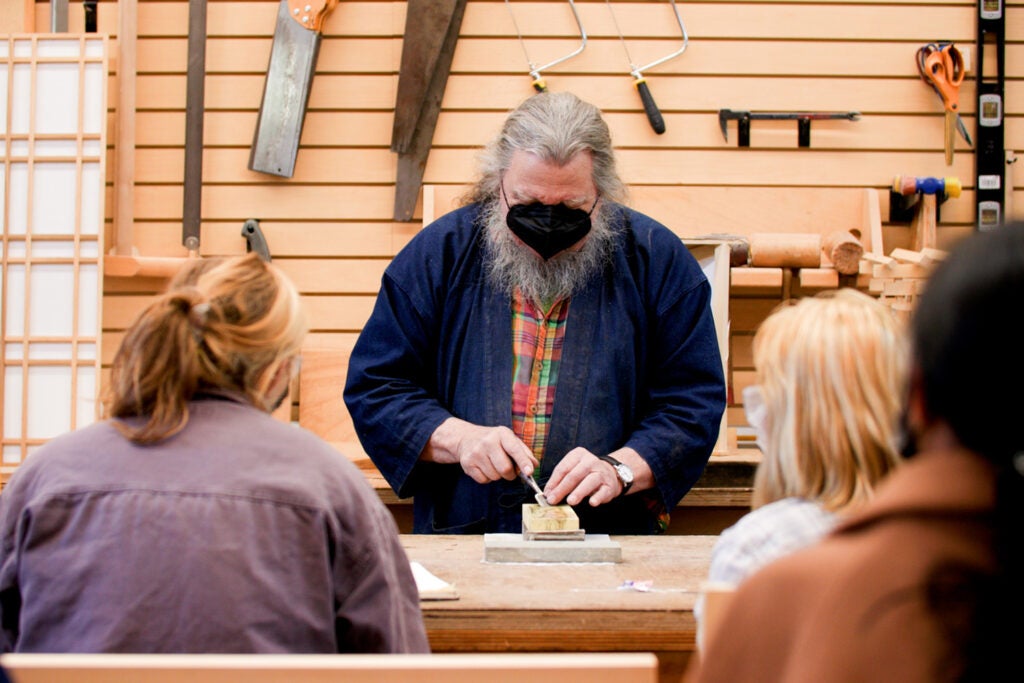New course exposes students to the beauty of Japanese functional objects
In a course that debuted in the winter 2022 quarter, students learn about culturally significant Japanese objects and the blurred boundary between aesthetics and practicality.
On Feb. 16, students in the Japanese Functional Objects class met their new tools in Stanford University’s Product Realization Lab (PRL). It was the first day of their woodworking unit and rhythmic scrapes and buzzes echoed throughout the room as about a dozen pairs of hands practiced honing their chisels and cutting through lumber with their pull saws.
Go to the web site to view the video.
Through this, the students learned the beauty to be found not just in the objects they create but in the tools themselves.
Winter 2022 serves as the debut quarter for Japan 126, a class led by Hideo Mabuchi, Craig Milroy, and Ariel Stilerman, and sometimes instructed by Jay van Arsdale, a craftsman with decades of experience in Japanese woodworking, and Momoyo Lowdermilk, a master of Japanese flower arrangement. This new course teaches students about culturally significant Japanese objects and the blurred boundary between aesthetics and practicality. In this unique interdisciplinary experience, students across majors – from art history to engineering – practice Japanese ceramics and woodworking and become familiar with the tools and traditions involved in their creation.
“One of the things that Stanford does is create these opportunities for cross-pollination of thinking and ideas,” said Milroy, co-director of the PRL and senior lecturer in the Department of Mechanical Engineering in the School of Engineering. “Here, we’re putting different kinds of students in a room together, each showing and witnessing different approaches, and it makes them all the better for it.”
The brainchild of many
This class was created as an unofficial continuation of the lessons taught in the Japanese Tea Ceremony class led by Stilerman, assistant professor in the Department of East Asian Languages & Cultures in the School of Humanities and Sciences. As a long-time student of Japanese culture, he aims for his classes to help others experience and appreciate Japanese cultural practices.

Woodworker Jay van Arsdale gives students in the course Japanese Functional Objects their first lesson in using Japanese hand tools. (Image credit: Harry Gregory)
“My goal is to figure out how to convey that beauty and that interest for people who are not in Japan,” said Stilerman, “how we can bring Japan to California.”
Stilerman has taught courses on the Japanese Tea Ceremony at various institutions and has always tried to include participatory experiences, from visiting the backroom of major museums to making one’s own teabowl to partaking in a tea ceremony in a traditional tearoom. Wanting to do this at Stanford as well, he contacted Milroy to see how the PRL could be used in a hands-on experience for his students.
Together, Stilerman and Milroy created the concept for this class. Since Milroy’s expertise is in woodworking, he and Stilerman contacted Mabuchi, a professor in the Department of Applied Physics in the School of Humanities and Sciences, who is a ceramic artist.
This class was truly able to come to fruition when a donor approached Milroy from the Halpern Family Foundation in November 2019. This donor wished to support a course taught across different departments and disciplines, like Japan 126. Their donation allowed for the purchase of all the materials and tools including quality Japanese hand tools: handplanes, saws, and chisels. This was crucial because these tools differ from similar Western equipment – a Japanese pull-stroke saw, for example, allows for higher levels of precision and finesse than a European push-stroke tool.
The coronavirus pandemic delayed the first offering of the course but following the full reopening of the PRL in Fall 2021, the instructors launched their class as intended – immediately following the tea ceremony course.
The Japanese Functional Objects course teaches the context of Japanese craft through lectures and discussion on its history and cultural context, while also introducing the materials through object studies and instruction on Japanese craft techniques – the first half of the course focuses on ceramics and the second half focuses on woodworking.
Haptic learning
One of the first things this course aims to teach students is the inessential distinction between fine art and practical tools in Japanese culture.
“An aesthetic object acquired its cultural identity and social value precisely because it could be used,” the instructors noted in the course syllabus. “How do the qualities of a tool-in-use help to coalesce a sense of meaning of the act of making, or of the tool itself?”
Mabuchi explained the Japanese word “dōgu,” whose simplest translation is tool or utensil. The tea ceremony utensils discussed throughout the Tea Ceremony and the Japanese Functional Objects courses – considered fine art in Western cultures – fall under the category of dōgu.
“At the same time, the tools that the students are learning about today – chisels, saws, and those kinds of things – those are also dōgu,” Mabuchi said.
It’s emphasized that the users of these ceremonial objects were often also the creators of the objects themselves. Therefore, in practicing how to create these objects alongside learning the cultural significance themselves, the students can appreciate this cultural art as intended.
Many students enrolled in this class from Stilerman’s Japanese Tea Ceremony class. One student, Victoria Hill, a senior undergraduate studying art history, said she loved the tea ceremony course and wished to learn about it from a new angle – since she’s interested in art practice.
The objects the students produced include ceramic vases meant to contain one flower and wooden platforms to contain these vases. These objects relate to the ceremonial tokonoma niche, a distinctive aspect of domestic Japanese architecture. Now that the course is complete, the student’s work is on exhibit at the East Asia Library for the spring quarter.